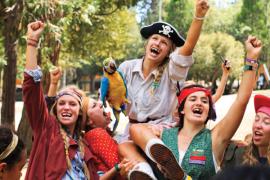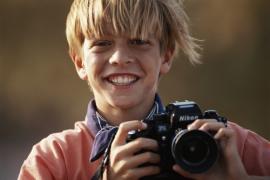“You’ll shoot your eye out!” Ralphie Parker’s mother, teacher, and even Santa Claus uttered five words of warning in the 1983 classic movie A Christmas Story. All Ralphie wanted for Christmas was “an official Red Ryder carbine-action two-hundred-shot range model air rifle with a special sight and a compass in the stock with a sundial!” The perfect gun for “pranging ducks . . . and getting off spectacular hip shots” (Shepherd, Clark, & Brown, 1982).
That 1940s Christmas morning, nine-year-old Ralphie believed the “conspiracy of irrational prejudice against Red Ryder and his peace-maker” (Shepherd, Clark, & Brown, 1982) was a reality until his father made it known that one present remained undiscovered.
If you are familiar with the movie, you know Ralphie tore into the package, pulled the gun out of the box, loaded it inside the house, rushed outside, stood a short distance from a target tacked to a tin sign, sighted over the barrel, and squeezed the trigger. A predictable sequence of events unfolded. The gun let out a crack. The .177 BB hit the target, ricocheted off the tin sign, and struck Ralphie in the cheek. Ralphie lost his glasses and fell to the ground. Moments later, his panicked search for his glasses results in their pulverization (Dupont & Clark, 1983).
The endearing story of a boy’s quest for his first gun comes with an underlying moral. A young person’s spark (Arnold, 2018) to own and use a firearm can come at considerable personal and family cost if the first pull of the trigger is done before there is an opportunity to develop behaviors that demonstrate a respect for the responsibilities of using a firearm. In the National 4-H Shooting Sports Program, these behaviors are called marksman cognition skills. These skills are the ability to memorize, recall, internalize, and generalize actions necessary to safely and responsibly use firearms.
Clearly the words of Red Ryder alone, “Kids, never fire a BB gun in the house. I never shoot anybody but bad guys, and I don’t want any of my friends hurt” (Shepherd, Clark, & Brown, 1982), were not sufficient in preventing a minor injury that could have been much worse.
Safe and Responsible
The subtext to Ralphie’s story is a reminder that not all youth receive the proper education and hands-on experience necessary to safely and responsibly use archery equipment or firearms (herein firearms). Residential and day camps often provide campers with their first encounter with firearms. ACA-accredited camps hire staff for specialized activities, such as shooting sports, who have the required certification and experience. Yet developing marksman cognition skills goes beyond ACA standards such as Program Design and Activities: Program, Specialized Activities, PD.8 Archery Safety and Program Design and Activities, Specialized Activities, PD.9 Rifle, Pellet Gun, and Air Gun Safety (ACA, 2019).
This information that follows is intended to help camp administrators select the right staff for the job and appropriate instruction processes by shedding some light on what brain development, social variables, and contextual factors should be in place to develop the marksman cognition skills that enable campers to safely and responsibly use firearms.
Brain Development, Social Learning, and Positive Environment
The frontal lobes of the brain that control “judgment, insight, empathy, [and] impulse control” (Your Teen Magazine, 2018) start their journey to maturity between the ages of six and ten and continue to do so well into the twenties (Jensen & Nutt, 2015; Silveri, 2015). It is during these early years that memory becomes more efficient (Jensen) and upon which memory, recollection, internalization, and generalization are built.
The myelination of axons and pruning of young brain cells begins around eight years of age and continues through the early twenties (Jensen & Nutt, 2015; Silveri, 2015). The result is that youth might know right from wrong but have yet to develop the mental capacity to avoid wrong answers or unethical and unwise actions (Silveri, 2015). The reason: the capability to make a good judgement comes from activity in the frontal cortex, “the parts of the brain that are still under construction” (Jensen & Nutt, 2015). The great thing about the brain is that it never really stops maturing. According to Jensen, the more that is learned, the easier learning gets.
Camps provide the positive environment for children to discover and explore interests, values, and talents (American Camp Association, 1997) through learning that is hands-on and experiential in nature (Arnold, Bourdeau & Nagele, 2005). The maturing brain is highly impressionable according to Jensen and Nutt (2015). The camp experience allows youths to observe, imitate, and model (Bandura, 1977) behaviors and actions that are necessary to develop the marksman cognition skills critical to the safe and responsible use of firearms. (see Table 1).
Coaches, Campers, and Firearms
The National 4-H Shooting Sports Program trains adults to work with youth in 4-H camps and clubs across the nation. In this program, adult coaches learn to use the acronym MAT for muzzle, action, and trigger to assist youth with recall as they handle the firearm.
Campers who, in turn, express out loud safety steps when prompted by a coach, develop the ability to use recollection to immediately retrieve memories about the safe and responsible use of firearms. For example, “‘M’ is for muzzle, keep it down range. ‘A’ is for action, keep it open and empty until ready to fire. ‘T’ is for trigger, keep your fingers off until ready to fire.”
The transition to internalization begins when, without prompting, campers’ actions become second nature. For example, coaches, counselors, and other campers expect and witness adherence to MAT.
Finally, the ability to generalize safe and responsible actions manifest themselves in multiple contexts. Not only do campers begin to understand the dangerous consequences of mishandling firearms, but they begin to engage in a larger goal of health and well-being for themselves and others. For instance, they have the confidence to remind other youth and adults to be mindful of MAT, because they have been taught to consider firearms to be loaded, off safety, and ready to fire until proven otherwise.
Shooting Sports Programs
Regardless of a youth’s ability to memorize, recollect, internalize, and generalize, youth remain sensation seeking and risk-taking machines who will make mistakes (Jensen & Nutt, 2015). Given the possible disastrous consequences in a shooting sports program, mistakes must be guarded against at all levels. Engagement in the safe and responsible use of firearms at an early age is only part of the process to nurture the developing brain. If camping experiences increase campers’ curiosity and interest in firearms, for safety’s sake, they need to be directed to youth development programs where they can observe, imitate, and engage in all aspects of a high-quality shooting sports program.
Intentional Planning and Instruction
Camps with intentionally planned programs and trained instructors can offer the controlled environment that youth need to explore their curiosity or interest in firearms. Coaches need to monitor the development of cognition skills related to the use of firearms. Around the ages of ten to 14, skills for remembering and doing lag behind in the growing and developing child (Jensen & Nutt, 2015). It is critical to identify the point at which actions become repeatable and second nature before more advanced or sophisticated firearms are introduced (e.g., transitioning from BB gun to pellet to small-bore firearms).
In a high-quality program, three key safety principles are critical.
- Youth must be supervised by coaches who have been screened and undergone a rigorous shooting sports training and certification program.
- Youth and adult fidelity to MAT are the primary safety procedures versus reliance and dependence on mechanical firearms safety mechanisms that can and do fail.
- Programs must adhere to a minimum age requirement for youth to be at least nine years old before participating in any live-fire activity using firearms or archery equipment.
Safe, Impactful Programs
There are many Ralphies in the world. Driven by their curiosity, youth seek out answers on their own. In some cases, the observation and imitation of uninformed friends, peers, and adults can lead youth to bring undesirable firearm behaviors to camp. The frontal lobes are the late-blooming parts of the brain. The young, impressionable brain is an active construction zone where brain cells are constantly connecting and building pathways that lead to better abstract thinking, distinguishing between hypothetical and real, processing of information, considering of problems from all angles, and self-reflection (Keating, 1990). By selecting specialized activity staff for each shooting sports program who have both specialized firearms training skills and an understanding of youth development, directors can be assured of safe, impactful programs.
The 4-H Shooting Sports Program |
|
The National 4-H Shooting Sports Program offers firearms education, training, and certification based on current youth development theory. Camp administrators are encouraged to contact their state’s 4-H Shooting Sports Coordinator about coach/instructor training workshops; visit 4-hshootingsports.org/state_contacts.php for coordinators in your state. 4-H Shooting Sports Coordinators can also help camp administrators connect campers with long-term firearms education beyond the camp experience through the 4-H club-based program. |
Photo courtesy of David J. White, Oregon State University, Oregon State University, Redmond, Oregon.
References
American Camp Association. (2018). Standards at a glance, 2019 edition. Retrieved from: ACAcamps.org/sites/default/files/Fully%20updated%20standards%20at%20a%20glance%20%28for%202019%29.pdf
American Camp Association. (1997). Getting the word out, 1997/98 edition [Brochure]. Martinsville, IN: ACA.
Arnold, M. E. (2018). From context to outcomes: A thriving model for 4-H Youth Development Programs. Journal of Human Sciences and Extension, 69(1), 141–160.
Arnold, M. S., Bourdeau, V. D., & Nagele, J. (2005). Fun and friendship in the natural world: The impact of Oregon 4-H residential camping programs on girl and boy campers. Journal of Extension, 43(6), 6RIB1.
Bandura, A. (1977). Social learning theory. New York, NY: General Learning Press.
Dupont, R., & Clark, B. (Producers), & Clark, B. (Director). (1983). A Christmas Story [Motion picture]. United States of America: Warner Bros.
Jensen, F. E. (2018). What were you thinking!?! Understanding the teenage brain. Your Teen Magazine. Retrieved from yourteenmag.com/health/physical-health/the-teenage-brain-book
Jensen, F. E., & Nutt, A. E. (2015). The teenage brain: A neuroscientist’s survival guide to raising adolescents and young adults. New York: HarperCollins Publishers.
Keating, D. P. (1990). Adolescent thinking. In S. S. Feldman and G. R. Elliott, (Eds.), At the threshold: The developing adolescent (pp. 54–89). Cambridge, MA: Harvard University Press.
Shepherd, J., Clark, B., & Brown, L. (1982). A Christmas story. Retrieved from dailyscript.com/scripts/AChristmasStory.pdf
Silveri, M. M. (2015). What were you thinking?! – Understanding the neurobiology of the teen brain. The Dana Foundation. Retrieved from dana.org/Publications/ReportOnProgress/What_Were_You_Thinking_Understanding_the_Neurobiology_of_the_Teen_Brain/
David J. White, an associate professor with Oregon State University, currently serves as the state 4-H youth development specialist for Outdoor Education & Recreation and state shooting sports coordinator. As a Western Region representative to the National 4-H Shooting Sports Committee, he provides leadership for coordinator instruction, curriculum development, and evaluation. He is a certified 4-H shotgun and muzzleloading instructor.
Jeff Goodwin has served in various capacities throughout his 36-year Extension career, including county Extension agent (Texas), state 4-H specialist (University of Idaho), and state 4-H program leader in Colorado and currently in Hawaii at the University of Hawaii, Manoa. Goodwin has also served for 17 years on the National 4-H Shooting Sports Committee.
Nicole L. Pokorney, an associate professor with the University of Minnesota, currently serves as the Minnesota 4-H Outdoor Adventures coordinator. As a Central Region representative to the National 4-H Shooting Sports Committee, she provides leadership to the National 4-H Shooting Sports Teen Ambassador Institute and partnership development.
Virginia D. Bourdeau currently serves as the state 4-H specialist for camping, natural sciences, and STEM. She is the former Oregon 4-H Shooting Sports coordinator.


